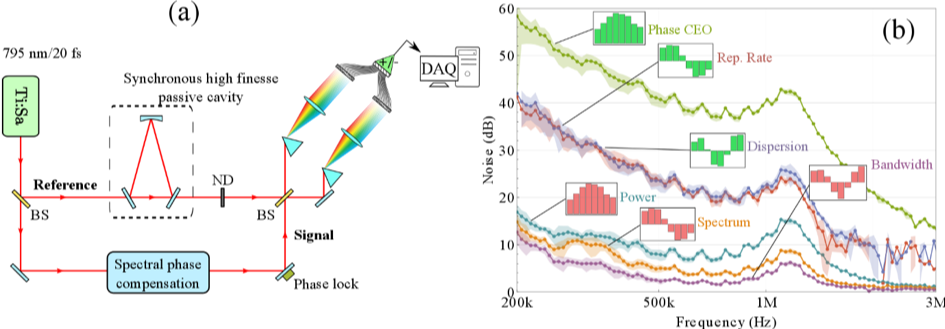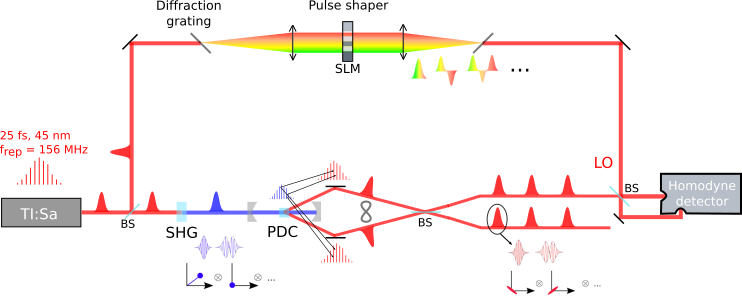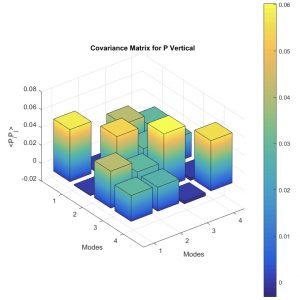Modal approach to multi-parameter estimation
TEAM MEMBERS
PERMANENT STAFF
- Claude Fabre
- Nicolas Treps
- Valentina Parigi
- Mattia Walschaers
POST-DOCS
- Giacomo Sorelli
PHD STUDENT
- Matthieu Ansquer
- Tiphaine Kouadou
Multimodal approach to parameters estimation
We have 2 main project
-
Laser dynamics
-
Multimode single-pass squeezing
Laser dynamics
Publications
- R. Schmeissner, J. Roslund, C. Fabre & N. Treps – “Spectral Noise Correlations of an Ultrafast Frequency Comb”, Phys. Rev. Lett. 113, 263906 (2014)
- V. Thiel, J. Roslund, S. De, C. Fabre, & N. Treps – “Recovering the dynamics of optical frequency combs from phase-amplitude noise correlations measurements”, arXiv preprint arXiv:1806.02198(2018)
Mode-locked femtosecond lasers have found many applications in experimental physics since they have been proved to be useful as a frequency standard, known as frequency comb (FC). It has now become a common tool in metrology for example in spectroscopy, range measurement, as well as for optical clocks. In most of the case the precision of the measurement is limited by the stability of the FC.
For a single frequency laser, noises are typically separated in amplitude noises (i.e. variation in the photon number) and phase ones (i.e. variation in frequency). However, for a FC composed of roughly 105 spectral lines, amplitude and phase noises affect each of them individually. Besides, it has been theorised that the noise dynamic of a FC can be described by four distinct parameters namely, the pulse energy, the carrier envelope offset, the timing jitter of the pulse train and the central wavelength of the spectrum, which indicates non-negligible correlations between the different spectral lines. A variation in one of these parameters affects the comb in a manner that consists in adding a particular noise mode to the unperturbed mode, the mean-field mode.


We are analysing the dynamic of a frequency comb using a multipixel homodyne detection. This scheme allows the analysis of the laser’s noises in separated spectral bands as well as their correlations. The noise modes are retrieved by eigendecomposition of the phase and amplitude covariance matrices. Those eigenmodes are found to be in good agreement with the theoretical ones associated to the four previous parameters [1]. We are thus able to characterise the dynamic by identifying each noise individually. Further investigation will try to identify the different “knobs” to act on in order to reduce one particular noise.
Correlations between phase and amplitude noises are also investigated [2]. Those correlations have only been studied by a few groups leaving open a wide field of studies which may bring new insight on the mode-locking process.
References
- [1] R. Schmeissner, J. Roslund, C. Fabre & N. Treps – “Spectral Noise Correlations of an Ultrafast Frequency Comb”, Phys. Rev. Lett. 113, 263906 (2014)
- [2] V. Thiel, J. Roslund, S. De, C. Fabre, & N. Treps – “Recovering the dynamics of optical frequency combs from phase-amplitude noise correlations measurements”, arXiv preprint arXiv:1806.02198(2018)
Multimode single-pass squeezing
Publications
Multipartite entanglement [1] is a major tool in the implementation of quantum information protocols. Cluster states of light e.g., are quantum complex networks featuring multipartite entanglement and are considered a resource for measurement-based quantum computation (MBQC) protocols [2]. The fabrication of such states was already achieved in our team [3]. In a more recent work, we have built a new experimental setup to produce multimode squeezed states of light via spontaneous parametric down conversion (SPDC) to constitute the building blocks of new clusters. The noncollinear configuration of the nonlinear process allows us performing single-pass generation of CV-entangled pulses, which are recombined at a balanced beamsplitter afterwards to produce squeezed states featuring an enriched multimode structure combining spatial and spectral features [4].

Our source is a mode-locked Ti:Sa laser delivering 25-fs pulses at a 156-MHz rate, which corresponds to a frequency comb (FC) centered at 795 nm and of 45-nm spectrum. At the laser output, the light beam is divided in two parts. The first part constitutes the reference beam for homodyne detection while the second part undergoes second harmonic generation before pumping a spontaneous parametric-down-conversion process through a nonlinear crystal placed in an optical cavity. In contrast to OPOs, where signal and idler beams are emitted in the same direction and resonate in a cavity, in our configuration, the cavity is kept for the pump beam and the phase matching is optimized for a noncollinear emission, which enables generating EPR-like states (two-mode squeezed vacuum) with signal and idler pulses exiting the cavity without resonating in it. Then, the FCs are recombined at a balanced beamsplitter to produce multimode squeezed states. The characterization is performed via balanced homodyne detection (BHD) by means of a spatially and spectrally shaped reference (LO). This technique enables the separate measurement of different light modes and was employed to reveal specific quantum correlations between four spatio-temporal modes. The covariance matrix associated to these modes is shown on Figure. 
References
- S. Gerke, J. Sperling, W. Vogel, Y. Cai, J. Roslund, N. Treps and C. Fabre, “Full Multipartite Entanglement of Frequency-Comb Gaussian States”, Phys. Rev. Lett. 114, 050501 (2015);
- G. Ferrini, J. Roslund, F. Arzani, C. Fabre, and N. Treps, “A direct approach to Gaussian measurement based quantum computation”, Phys. Rev. A 94, 062332 (2016);
- Y. Cai, J. Roslund, G. Ferrini, F. Arzani, X. Xu, C. Fabre and N. Treps, “Multimode entanglement in reconfirable graph states using optical frequency combs” – Nature Communication, DOI: 10.1038/ncomms15645 (2017);
